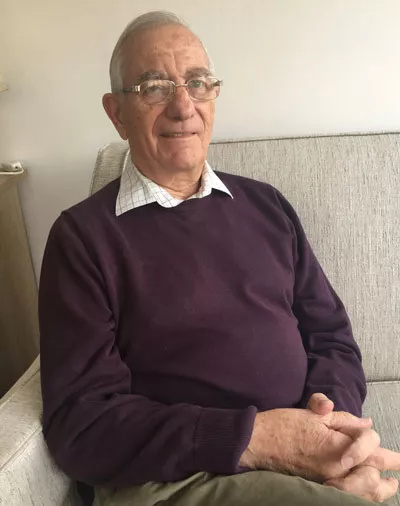Grandfather thanks pioneer who saved his sight in the 1950s
Friday 7 February 2020

A grandfather has recalled what it was like to be one of the first people to have modern cataract surgery at St Thomas’ Hospital in the 1950s.
Saturday 8 February marks the 70th anniversary of the first successful lens implant operation, which was developed by Sir Harold Ridley, an ophthalmologist at St Thomas’ Hospital. His medical breakthrough has saved the sight of more than 200 million people across the world.
Jeffrey Wright, 80 from Milton Keynes, was one of the first patients to be operated on by Sir Harold in 1956 when he was 16. He accidentally pierced his right eye while playing darts. As a result he developed cataracts, a clouding of the lens in the eye which leads to a decrease in vision.
Jeffrey, a retired electrical engineer, said: “Initially I was told by my local hospital that I’d never be able to see with my right eye but my mum refused to accept that. We were eventually referred to Sir Harold Ridley at St Thomas’. What he was doing wasn’t widely known about then but he said he could help me.
“By then the lens in my eye had gone opaque and my vision had started to get worse. Once my lens had been removed and the new one was inserted my vision was brilliant – and it stayed that way for 30 years.”
By 1986 Jeffrey’s artificial lens had started to rub against his cornea so it was removed at St Thomas’ and he was given contact lenses and a corneal graft. He said: “The team was amazed that the lens Sir Harold Ridley put in was still there. I’ve done very well with my sight for so long.
“He was a brilliant surgeon. I would have completely lost my vision in my right eye without him. It was great my mum pushed for treatment because my life could have been very different without vision in one eye.
“Sir Harold was a pioneer – now so many people have the operation each day thanks to what he discovered.”
Sir Harold made his medical breakthrough after treating a Spitfire pilot who had Perspex in his eye. He noticed that, unlike most foreign bodies, the eye did not reject Perspex. He used this discovery to create an artificial lens made of Perspex to replace those in eyes which became clouded by cataracts.
Previously people with cataracts had the cloudy lens of the eye surgically removed and then needed to wear powerful thick glasses. At the time Sir Harold’s invention was a radical concept, which was initially resisted by much of the medical profession. By the 1980s it had become a routine procedure but involved a 1cm incision, stitches and a two-week recovery.
Today it is the most common eye operation in the world. It has evolved and now only requires an incision of just 2mm to insert a lens which unfolds within the eye, no stitches and a same-day discharge. Some patients may even have no need to wear glasses afterwards.
Around 350,000 cataract operations are performed annually in the UK and St Thomas’ Hospital carries out more than 50 cataract operations every week, each taking 15 to 30 minutes.
Mr Nigel Davies, consultant ophthalmologist and head of the eye service at St Thomas’, said: “It’s always an honour to help patients, especially when it comes to saving their sight. There is something particularly special about doing that in the same place where Sir Harold Ridley invented modern cataract surgery. The eye team at St Thomas’ is very proud to carry on his legacy every day.
“Thanks to the procedure he developed, lives have been transformed across the world. His contribution to human health and wellbeing is enormous.”
St Thomas’ is the leading centre for cataract research in the UK. New research led by Professor David O’Brart, consultant ophthalmic surgeon, has explored the potential benefits of operating on both eyes at once which is not routinely offered in the NHS. The research has found doing this could reduce the length of time in hospital and recovery time, be more convenient for patients and improve productivity by up to 38%, leading to a more efficient use of operating theatres.
The next stage of the work will see the team present the research to commissioners with the hope of carrying out the new technique at St Thomas’.
Last updated: March 2022
Contact us
If you're a journalist and have a media enquiry, please contact us.
Phone: 020 7188 5577
Email: [email protected]